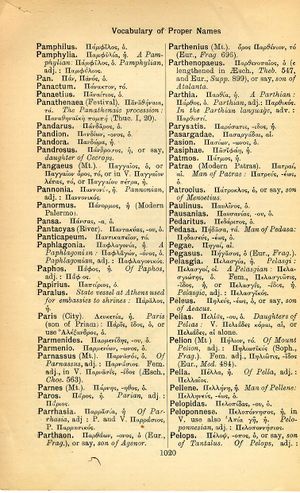Pelion: Difference between revisions
ἔνδον γὰρ ἁνὴρ ἄρτι τυγχάνει, κάρα στάζων ἱδρῶτι καὶ χέρας ξιφοκτόνους → yes, the man is now inside, his face and hands that have slaughtered with the sword dripping with sweat
(6_12) |
m (Text replacement - "]]>" to "]]") |
||
| Line 5: | Line 5: | ||
}} | }} | ||
{{Lewis | {{Lewis | ||
|lshtext=<b>Pēlĭon</b>: ii (<br /><b>I</b> masc. collat. form Pēlĭos, Plin. 4, 8, 15, § 30: Pelio, scanned as a dissyl. per syniz., Sil. 3, 495), n., = [[Πήλιον]] | |lshtext=<b>Pēlĭon</b>: ii (<br /><b>I</b> masc. collat. form Pēlĭos, Plin. 4, 8, 15, § 30: Pelio, scanned as a dissyl. per syniz., Sil. 3, 495), n., = [[Πήλιον]], a [[high]] [[mountain]] in [[Thessaly]], a [[continuation]] of [[Ossa]], [[now]] Zagora, Plin. 2, 65, 65, § 162; Verg. G. 1, 281; 3, 94; Ov. M. 12, 513; 1, 155; Mel. 2, 3, 2.—Hence,<br /> <b>A</b> Pēlĭăcus, a, um, adj., of or belonging to [[Pelion]]: [[vertex]], Cat. 64, 1: [[apex]], Ov. F. 1, 308: juga, Stat. Achill. 1, 321: [[trabs]], i.e. the [[Argo]] ([[because]] built of [[timber]] from [[Pelion]]), Prop. 3 (4), 22, 12: Peliaca [[carina]], Val. Fl. 8, 417; cf. also: Peliaca [[cuspis]], of [[Achilles]], [[cut]] on [[Pelion]], Ov. M. 12, 74: [[axis]], the [[chariot]] of [[Achilles]], Sen. [[Troad]]. 414.—<br /> <b>B</b> Pēlĭus, a, um, adj., of or belonging to [[Pelion]], Pelian: [[mons]], Cic. Fat. 15, 35: in nemore Pelio, Enn. ap. Auct. ad Her. 2, 22, 34 (Trag. v. 280 Vahl.); so, in [[imitation]], [[nemus]], Phaedr. 4, 7, 6.—<br /> <b>C</b> Pēlĭas, ădis, f. adj., [[that]] [[comes]] from [[Pelion]]: [[Pelias]] [[hasta]], the [[spear]] of [[Achilles]] ([[because]] its [[shaft]] came from [[Pelion]]), Ov. H. 3, 126: [[pinus]], the [[Argo]], Stat. Th. 5, 335.—As subst.: Pēlĭas, ădis, f., a [[spear]], Auct. [[Pan]]. ad Pis. 165. | ||
}} | }} | ||
Revision as of 09:30, 13 August 2017
English > Greek (Woodhouse)
(Mt.) Πήλιον, τό.
Of Mount Pelion, adj.: Πηλιωτικός (Soph., Frag.). Fem. adj., Πηλιῶτις, -ιδος (Eur., Med. 484).
Latin > English (Lewis & Short)
Pēlĭon: ii (
I masc. collat. form Pēlĭos, Plin. 4, 8, 15, § 30: Pelio, scanned as a dissyl. per syniz., Sil. 3, 495), n., = Πήλιον, a high mountain in Thessaly, a continuation of Ossa, now Zagora, Plin. 2, 65, 65, § 162; Verg. G. 1, 281; 3, 94; Ov. M. 12, 513; 1, 155; Mel. 2, 3, 2.—Hence,
A Pēlĭăcus, a, um, adj., of or belonging to Pelion: vertex, Cat. 64, 1: apex, Ov. F. 1, 308: juga, Stat. Achill. 1, 321: trabs, i.e. the Argo (because built of timber from Pelion), Prop. 3 (4), 22, 12: Peliaca carina, Val. Fl. 8, 417; cf. also: Peliaca cuspis, of Achilles, cut on Pelion, Ov. M. 12, 74: axis, the chariot of Achilles, Sen. Troad. 414.—
B Pēlĭus, a, um, adj., of or belonging to Pelion, Pelian: mons, Cic. Fat. 15, 35: in nemore Pelio, Enn. ap. Auct. ad Her. 2, 22, 34 (Trag. v. 280 Vahl.); so, in imitation, nemus, Phaedr. 4, 7, 6.—
C Pēlĭas, ădis, f. adj., that comes from Pelion: Pelias hasta, the spear of Achilles (because its shaft came from Pelion), Ov. H. 3, 126: pinus, the Argo, Stat. Th. 5, 335.—As subst.: Pēlĭas, ădis, f., a spear, Auct. Pan. ad Pis. 165.

